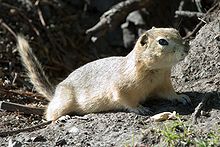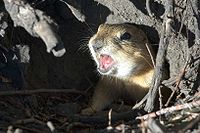Richardson's ground squirrel: Difference between revisions
m Reverted edits by 69.149.235.126 (talk) to last version by Ian Dalziel |
|||
| Line 23: | Line 23: | ||
Native to the short grass [[prairie]]s, Richardson's Ground Squirrel is found mainly in the northern states of the [[United States]], such as [[North Dakota]], and in southern [[Canada]], such as southern [[Alberta]] and Southern [[Saskatchewan]]. The range of this animal expanded as forests were cleared to create farm land. They are not simply restricted to prairie, sometimes adapting to suburban environments, causing them to be seen as pests from the burrows they dig. |
Native to the short grass [[prairie]]s, Richardson's Ground Squirrel is found mainly in the northern states of the [[United States]], such as [[North Dakota]], and in southern [[Canada]], such as southern [[Alberta]] and Southern [[Saskatchewan]]. The range of this animal expanded as forests were cleared to create farm land. They are not simply restricted to prairie, sometimes adapting to suburban environments, causing them to be seen as pests from the burrows they dig. |
||
==Description== |
==Description== |
||
Typical adults are about 30 cm long. Weights vary greatly with time of year and with location: at emergence from [[hibernation]] the squirrels weigh between 200 and 400 grams, but by the time they hibernate again this may have risen to nearly 750 grams; males are slightly larger and heavier than females on average. They are dark brown on the upper side and tan underneath. The tail is shorter and less bushy than in other ground squirrels, and the external ears are so short as to look more like holes in the animal's head. Behavior is more like that of a [[prairie dog]] than a typical ground squirrel. The tail is constantly trembling, so the animal is sometimes called the "Flickertail". |
Typical adults are about 30 cm long. Weights vary greatly with time of year and with location: at emergence from [[hibernation]] the squirrels weigh between 200 and 400 grams, but by the time they hibernate again this may have risen to nearly 750 grams; males are slightly larger and heavier than females on average. They are dark brown on the upper side and tan underneath. The tail is shorter and less bushy than in other ground squirrels, and the external ears are so short as to look more like holes in the animal's head. Behavior is more like that of a [[prairie dog]] than a typical ground squirrel. The tail is constantly trembling, so the animal is sometimes called the "Flickertail".i like chicken |
||
==Behavior== |
==Behavior== |
||
[[Image:Richardson's-Ferocity-Szmurlo.jpg|left|thumb|200px|Exhibiting territorial behavior]] Although they are territorial around their nest sites, the burrows of Richardson's Ground Squirrels are grouped closely together in colonies, and individuals give audible [[alarm call]]s when possible predators approach. Recent research has shown that in some cases, [[ultrasonic]] alarm calls are given, and are responded to by other members of the colony. Offspring genetically have the same calls as their parents so parents can pick up on thier own offspring's call when they are in danger.{{cn}} |
[[Image:Richardson's-Ferocity-Szmurlo.jpg|left|thumb|200px|Exhibiting territorial behavior]] Although they are territorial around their nest sites, the burrows of Richardson's Ground Squirrels are grouped closely together in colonies, and individuals give audible [[alarm call]]s when possible predators approach. Recent research has shown that in some cases, [[ultrasonic]] alarm calls are given, and are responded to by other members of the colony. Offspring genetically have the same calls as their parents so parents can pick up on thier own offspring's call when they are in danger.{{cn}} |
||
Revision as of 17:40, 21 April 2008
This article needs additional citations for verification. (December 2007) |
| Richardson's Ground Squirrel | |
|---|---|

| |
| Scientific classification | |
| Kingdom: | |
| Phylum: | |
| Subphylum: | |
| Class: | |
| Order: | |
| Family: | |
| Genus: | |
| Species: | S. richardsonii
|
| Binomial name | |
| Spermophilus richardsonii | |
Richardson's Ground Squirrel (Spermophilus richardsonii), or the Flickertail, is a North American ground squirrel in the genus Spermophilus. Like a number of other ground squirrels, they are sometimes called "Dak Rats" or "gophers", though this name belongs more strictly to the pocket gophers of family Geomyidae.
Name
It was named after the Scottish naturalist Sir John Richardson. The Gopher Hole Museum in Torrington, Alberta, Canada, has a large selection of stuffed ground squirrels of many varieties and colors. North Dakota is nicknamed after the squirrel: The Flickertail State.
Habitat
Native to the short grass prairies, Richardson's Ground Squirrel is found mainly in the northern states of the United States, such as North Dakota, and in southern Canada, such as southern Alberta and Southern Saskatchewan. The range of this animal expanded as forests were cleared to create farm land. They are not simply restricted to prairie, sometimes adapting to suburban environments, causing them to be seen as pests from the burrows they dig.
Description
Typical adults are about 30 cm long. Weights vary greatly with time of year and with location: at emergence from hibernation the squirrels weigh between 200 and 400 grams, but by the time they hibernate again this may have risen to nearly 750 grams; males are slightly larger and heavier than females on average. They are dark brown on the upper side and tan underneath. The tail is shorter and less bushy than in other ground squirrels, and the external ears are so short as to look more like holes in the animal's head. Behavior is more like that of a prairie dog than a typical ground squirrel. The tail is constantly trembling, so the animal is sometimes called the "Flickertail".i like chicken
Behavior

Although they are territorial around their nest sites, the burrows of Richardson's Ground Squirrels are grouped closely together in colonies, and individuals give audible alarm calls when possible predators approach. Recent research has shown that in some cases, ultrasonic alarm calls are given, and are responded to by other members of the colony. Offspring genetically have the same calls as their parents so parents can pick up on thier own offspring's call when they are in danger.[citation needed]
Hibernation
Flickertails hibernate; adult squirrels may hibernate as early as July, though in their first year, the young squirrels do not hibernate until September. The males emerge from hibernation in March, and establish territories before the females emerge a couple of weeks later. The young, up to 8 in a litter, are born in April or May. Abandoned burrows are sometimes taken over by other grassland species such as the burrowing owl.
Feeding
These animals are omnivores, eating seeds, nuts, grains, grasses and insects. Predators include hawks, weasels, badgers and coyotes. Because they will readily eat crop species, Richardson's Ground Squirrels are sometimes considered to be agricultural pests.
Extermination

Farmers and ranchers have developed some ingenious ways of exterminating gophers besides trapping, shooting and poisoning. One enterprising person in Colorado uses a large modified sewage vacuum truck to suck gophers out of dens and into the truck's tank. Another person developed a process that fills the burrows with a mixture of oxygen and propane and then ignites the gas mixture which kills the gophers with a concussive force that also collapses the tunnel systems[1]. While both solutions are effective, gophers from outside of the treated areas will eventually spread back into the area.
The Saskatchewan Wildlife Federation sponsored a 12-week "gopher derby" in 2002, in an effort to reduce what it considered an overpopulation of the squirrels. Cash prizes were awarded for the most number of animals killed, with the animals' tails being presented as proof of the kill. The Canadian Humane Society called the contest cruel and barbaric.[2] Despite the criticism, the derby was repeated in 2003. By 2004, the gopher population had dropped and the contest was cancelled.
References
- ^ "Gophers notch a win in man-rodent battle". Reuters. 2008-03-24. Retrieved 2008-03-25.
- ^ Humane society slams gopher-killing derby - CBC Saskatchewan
External links
- Xander.it - Spermophilus Richardsonii (Richardson's ground squirrels) videos
- American Society of Mammalogists species account (pdf)
- Information on keeping Richardson's Ground Squirrels as pets

